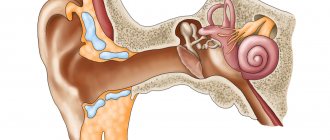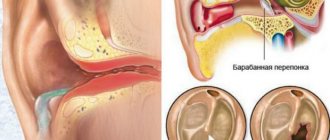Otitis of the exudative type is a pathological process in the ear, the course of which is traditionally associated with exudate accumulated inside. This form is the second stage of the inflammation process, which occurs as a complication of catarrhal disease. It is worth distinguishing this disease from the acute form of the secondary disease, which is represented by an inflammatory process due to infection. Most often, exudative otitis media of the middle ear is diagnosed in children, in 60% of situations. Moreover, the lion's share of them suffer from the disease at the age of 3-7, and 10% get sick at the age of 12-15.
Causes of the disease
The causative factors for the onset of the disease process are infectious phenomena in the nasopharynx and ENT organs. They are accompanied by excessive swelling in the mucous membrane, for example, ARVI, sinusitis, sinusitis. As a result, not only the mucous membrane in the nasopharynx, but also in the area of the Eustachian tube is exposed to pathology. As a result, the permeability and ventilation process deteriorate.
For this reason, the active development of the disease begins, and if there is no adequate treatment, a direct transition to the exudative stage is observed. In young children this process occurs extremely quickly.
Fluid constantly forms in the middle ear area, the removal of which is not particularly difficult. As a result of the inflammation process, the mucous membrane begins to intensively produce this fluid, and a narrowing of the ear tube is observed, making outflow more difficult.
Exudate gradually accumulates and entails an even greater narrowing of the element. The created environment creates favorable conditions for the proliferation of bacteria or viruses, which constantly spread, and the liquid takes the form of mucus.
If treatment for exudative otitis is not undertaken at this stage, the mucous fluid will become pus, and a purulent form of otitis will begin to develop.
There are several causative aggravating factors that affect the general course of the pathology:
- inflammatory diseases that form in the nose and nasopharynx;
- traumatic phenomena of the olfactory organ and curvature of the partitions of the entire cavity;
- inflammatory process in the area of the adenoids;
- serious diseases in the area of the Eustachian tube;
- general pathological processes, more often typhus, tuberculosis;
- reduction of immune body function;
- changes in temperature and pressure;
- penetration of water into the ear cavity and its accumulation.
A competent approach to determining the causative factor will allow you to engage in therapy as timely and rationally as possible.
Exudative otitis media in adults
Exudative otitis media is a long-term pathological process in the middle ear. The full cycle from the onset to the formation of irreversible hearing loss takes about 2 years. Long duration of disease progression increases the chances of cure, even if time was lost initially.
The cause of the exudative form of otitis media is a chronic inflammatory process or acute viral disease of the upper respiratory tract. Since the spread of inflammation in the middle ear begins from the auditory tube, factors that predispose to the reflux of the nasopharyngeal environment into the auditory tube are of paramount importance in the development of the disease. These include:
- Anatomical features of the nasal cavity
- Neoplasms in the nasopharynx
- Reduced immunity
- Cold weather
At the first stage, which is also called catarrhal otitis or tubo-otitis, the entry of a pathogenic medium into the Eustachian tube leads to its swelling and narrowing of the lumen.
Under normal conditions, the entrance to the auditory tube is closed. When swallowing, a temporary opening of the entrance occurs, due to which air rises through the pipe, and, reaching the tympanic cavity, equalizes the pressure in it relative to that which exists on the other side of the eardrum - in the outer ear. Anyone can hear the penetration of air into the eardrum by the characteristic internal sound that appears as a result of the tension of the eardrum.
With catarrhal edema, the above mechanism stops working. The walls of the pipe are narrowed so much that they poorly or do not allow air into the tympanic cavity. Symptoms of the first stage of exudative otitis media:
- Itching in the nasopharynx and ears
- Ear congestion
- Sneezing and blowing your nose improves hearing
- Staying in cold air worsens congestion
- A runny nose is a common background symptom of the catarrhal stage
Treatment of the exudative form of otitis at the initial stage is aimed at restoring the patency of the Eustachian tube and preventing the reflux of pathogenic media from the nasopharynx
Of primary importance are:
- Therapy and cleansing of infectious foci of the nasal cavity, sinuses, inflammation in the oral cavity and pharynx.
- Correction of anatomical defects of the nasopharynx.
At this stage use:
- Vasoconstrictors (eg, Galazolin)
- Drugs that improve the flow of mucus from the tube (eg, Rinofluimucil)
- Immunostimulating agents (eg, IRS-19)
- Anti-inflammatory drugs (eg, fenspiride)
- Antibiotics - in cases of probable inflammation
- Blowing and other physical procedures (electrophoresis, laser therapy, electrical stimulation, etc.)
A positive response to therapy avoids the transition of tubo-otitis to the chronic stage
It is very important to achieve a cure at this stage
With further progression, the disease enters the secretory stage, which marks the beginning of liquid effusion (exudate) into the tympanic cavity.
The symptoms of the first stage of otitis media in exudative form are superimposed on those characteristic of the secretory phase of the disease:
- Feeling of heaviness and pressure in the ear
- Sensation of fluid and its “fluctuating” in the ear
- Significant hearing loss
A decrease in pressure in the tympanic cavity and excess pressure in the ear canal causes retraction of the eardrum into the middle ear and curvature of its plane. At the same time, this leads to a deformed position of the malleus relative to the incus. Taken together, these factors lead to two consequences:
- Chronic hearing loss.
- Increased risk of cholesteatoma formation.
Conservative treatment used at the catarrhal stage of the disease is also used in the secretory phase. If it is impossible to normalize the functioning of the Eustachian tube, they resort to puncture of the eardrum, suction of fluid from the tympanic cavity or its shunting - deeper cleaning with pumping medicines into the ear.
After another year, the exudate becomes so thick that the formation of adhesions, hard compactions, and fibrosis begins in it, which, among other things, lead to immobilization of the auditory ossicles and deafness.
At the mucosal and fibrotic stages, conservative treatment is not effective. Complete suction of the contents through the puncture is also not possible. Treatment of exudative otitis media at these stages involves opening the eardrum and thoroughly sanitizing the middle ear cavity.
Symptomatic picture of the disease phenomenon
The exudative form can be diagnosed quite easily, since the picture is accompanied by insufficiently expressed symptoms or their complete absence. The greatest difficulties arise in determining the disease in a young child, who himself is not able to tell his parents about what exactly is bothering him. Therefore, every parent undertakes to monitor the slightest changes in the behavior of the baby. There are several basic signs that 100% characterize this form of the disease:
- feeling of ear fullness;
- difficulties in terms of sound perception;
- nasal congestion;
- the opportunity for the baby to hear his own voice echo;
- feeling of water getting into the ear;
- mild short-term pain.
If at this stage there is no rational and adequate treatment at home or in a hospital, there is a possibility of progression to a permanent form of hearing loss.
Acute and chronic form of the disease
The disease can occur in three stages of formation and is composed of three varieties and qualities.
- The acute form lasts for a three-week period and is characterized by mild symptomatic signs. The course of acute exudative otitis differs in that it has pronounced symptoms and is very disturbing.
- The mid-acute stage involves progression of the disease over 8 weeks. The signs of manifestation of this form are the same as those of the previous one, only they may be dull and not so disturbing.
- Chronic exudative otitis media occurs continuously and develops from the acute form of the disease. Its symptoms are more dull, but they bother you throughout your life. This is especially common during the period of exacerbation of this form of the disease.
If the therapeutic complex is not provided in time at the first signs of the disease, chronic exudative otitis media begins to develop. Its course is complicated by persistent anxiety.
Symptoms
The difficulty in identifying the disease is that exudative otitis media has hidden symptoms that interfere with treatment. In medical practice, there have been cases where the disease smoothly turned into a chronic form, while the symptoms did not manifest themselves.
Let's look at the main symptoms of exudative otitis media:
- hearing impairment, up to short-term loss;
- it feels like there is a hard plug in the ear;
- when you turn your head sharply, you feel the presence of fluid in the ear;
- possible inflammatory processes in the nasopharynx;
- your own voice echoes in your ears.
Pain may be absent or short-lived. Unlike otitis media, body temperature remains normal.
Stages of the disease
The course of this form of the disease can last for many months. If treatment is not undertaken, hearing function may deteriorate. Despite the simplicity of treatment, the basic task of a specialist comes down to timely detection of the inflammatory process. ENT doctors in their practice distinguish 4 stages of the disease.
- The initial form suggests the presence of signs such as deterioration of auditory function. It can last for a month; due to a decrease in the auditory capacity, circulation in the entire organ deteriorates, and it becomes increasingly difficult for a person to hear.
- The secretory stage involves the formation of accumulation of secretions of a pathological nature. Under the influence of the infectious process, the discharge intensifies, and an increase in the number of goblet cell elements and secretory glands appears. The stage can last a year.
- The penultimate stage implies a clear description of the process in which the liquid acquires the property of viscosity and begins to fill the cavity of the middle ear. This process can last even 24 months, the liquid becomes excessively thick and can stick to ENT instruments.
- The fibrous stage is the final stage, as a result of which changes are detected in terms of the structure of the hearing aid. Against the background of deformation processes, damage is observed in the auditory bone, and the eardrum also changes its shape.
Sometimes and even often, bilateral exudative otitis may develop, in which both organs are affected. The acute disease lasts several months, while subsequent forms are called chronic varieties. Bilateral exudative otitis often occurs in the youngest patients under 7 years of age. This diagnosis indicates that the inflammatory process has affected the left (left-sided disease) and right (right-sided disease) ear.
Traditionally, the therapeutic process is carried out within a hospital setting, in which patients attend irrigation and bypass procedures.
Diagnostic measures for the disease
An ENT specialist is involved in diagnosing exudative otitis media. Therefore, when the first signs of the disease are detected, you need to contact and pay a visit to this doctor before the disease has time to develop into a purulent form.
The final decision is usually made on the basis of a visual examination and questioning of the patient regarding sensations and recent changes. Also in practice, doctors use an instrumental research method, which involves studying the nasal cavity and eardrum.
Treatment
The disease is diagnosed visually by a specialist. During the examination, the doctor, using the otoscopy method and examining the cavity of the eardrum, will immediately notice changes, determine their nature, and prescribe treatment.
To restore the full clinical picture, the otolaryngologist will definitely conduct additional studies. They are intended to identify the cause of the development of pathology, and in cases with young patients, to determine whether otitis media has affected hearing acuity.
Treatment depends on the diagnosis. Basically, the disease is eliminated with the help of complex drug therapy, including the use of anti-inflammatory non-steroidal drugs and mucolic drugs. The latter are designed to quickly liquefy and remove exudate.
The use of traditional medicine is possible only as an auxiliary and supportive method of treatment. Even rinsing the ear cavity with herbs that seems harmless at first glance should be agreed upon with the attending physician.
Features of the therapeutic process
In order for the disease to go away forever and no longer bother you, it is necessary to treat exudative otitis media. This involves the use of several techniques, each of which is aimed at relieving the signs and eliminating the symptoms of the disease. The remaining actions taken as part of the treatment of exudative otitis media are aimed at restoring hearing options and preventing the formation of changes.
If the disturbances occur due to diseases of the nasal cavity or pharynx, then at the initial stage treatment of the upper respiratory tract is performed.
Treatment of exudative otitis media is carried out in a complex manner. It involves the use of medications and a number of procedures. Based on the severity of the disease, there is a possibility that catheterization and subsequent ventilation of the ear canal will be necessary. Physiotherapy-related procedures have also gained popularity. The type of treatment process of this type is directly dependent on the degree of the disease. Typically, a course of treatment consists of 8 or 10 procedures.
Reasons for development
There are many factors influencing the development of otitis media. As you know, for proper functioning, a small amount of fluid is regularly produced in the middle ear cavity. This is a normal state of a healthy body. What we clean out of the ears through morning hygiene procedures is the remnants of this fluid. If the ear canals are swollen, inflamed, or have an abnormally small opening, exudative fluid begins to collect in the cavity.
Anatomical
Often, poor patency and accumulation of excess secretions occur against the background of acute and chronic diseases of the nasopharynx. Frequent untreated rhinitis, sinusitis and sinusitis are precursors of exudative otitis media. Another reason is catarrhal otitis, which has passed into the acute stage of development.
Adenoids
In children, pathology may appear against the background of adenoids, if the operation was not performed on time or the inflammatory process was not eliminated, congenital curvature of the nasal septum. Children are susceptible to developing otitis media due to uncontrolled swimming in pools and ponds in the summer, and hypothermia in the winter.
Professional activity
Complications in adults include professional activities. Exudative otitis media is a disease characteristic of pilots, submariners, and divers, whose work is specifically related to various types of barotrauma. In addition, the disease can develop against the background of cancer problems in the nasopharynx and sinuses, when the tumor blocks the ear canals.
Taking medications for illness
Of course, with exudative otitis media, symptoms and treatment are interrelated. Therefore, drugs and tablets are prescribed based on general signs and symptoms.
- Antibacterial drugs - but the feasibility and effectiveness of their use is still in question.
- Antihistamine drugs - their action is aimed at relieving swelling of the mucous membrane.
- Anti-inflammatory complexes along with vasoconstrictors give a quick optimal result; how to treat is determined by the doctor.
Children are treated using these groups of medications, but if the ear canal is not cured, a hospitalization method is used to restore hearing and improve the general condition of the ears.
Diagnostics
The possibility of developing exudative otitis is indicated by complaints of ear congestion and hearing loss, short-term pain in the ear area. The risk is increased if the patient has recently suffered a bacterial or viral disease of the upper respiratory tract, an exacerbation of allergies, or has pathologies of the nasopharynx.
After taking a history, the otolaryngologist examines the external auditory canal and eardrum through an otoscope or microscope. With exudative otitis media, the eardrum will be cloudy, retracted or bulging at the bottom. Its color varies from pink to bluish. The lumen can show fluid in the inner ear area, as indicated by air bubbles or a visually visible fluid level.
Endoscopic examination of the pharyngeal opening of the auditory tube can reveal narrowing of the auditory tube, the presence of adenoids, tumors and other mechanical obstructions.
To study the mobility of the tympanic membrane, a Valsalva maneuver, a study with a Siegle funnel or the tympanometry method are performed. With exudative otitis media, the mobility of the eardrum is reduced due to the accumulation of fluid in the middle ear.
A hearing test is also carried out using a tuning fork and audiometry (testing sensitivity to sounds of different frequencies).
In difficult cases, computed tomography of the temporal region is prescribed. An x-ray allows you to visually assess the middle ear cavity, the condition of the mucous membrane and the chain of auditory ossicles. If there is pathological content in the cavities, CT will show its location and density.
According to indications, diagnostic tympanocentesis can be performed - puncture of the eardrum and collection of contents for analysis. If necessary, a shunt is installed to drain fluid from the middle ear cavity.










